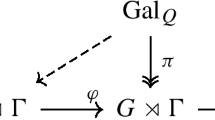Abstract
We show that two random elements of a finite simple groupG generateG with probability → 1 as |G| → ∞. This settles a conjecture of Dixon.
Similar content being viewed by others
References
Aschbacher, M. and Seitz, G. M.: Involutions in Chevalley groups over finite fields of even order,Nagoya Math. J. 63 (1976), 1–91; correction:ibid. 72 (1978), 135–136.
Babai, L.: The probability of generating the symmetric group,J. Combin. Theory Ser. A 52 (1989), 148–153.
Carter, R. W.: Conjugacy classes in the Weyl group, in A. Borelet al. (eds),Seminar on Algebraic Groups and Related Topics, Lecture Notes in Math. 131, Springer, Berlin, 1970, pp. 297–318.
Conway, J. H., Curtis, R. T., Norton, S. P., Parker, R. A. and Wilson, R. A.:Atlas of Finite Groups, Oxford Univ. Press, 1985.
Dixon, J. D.: The probability of generating the symmetric group,Math. Z. 110 (1969), 199–205.
Gorenstein, D. and Lyons, R.: The local structure of finite groups of characteristic 2 type,Memo. Amer. Math. Soc. 42, No. 276 (1983).
Iwahori, N.: Centralizers of involutions in Chevalley groups, in A. Borelet al. (eds),Seminar on Algebraic Groups and Related Topics, Lecture Notes in Math. 131, Springer, Berlin, 1970, pp. 267–295.
Kantor, W. M.: Some topics in asymptotic group theory, in M. W. Liebeck and J. Saxl (eds),Groups, Combinatorics and Geometry, London Math. Soc. Lecture Notes 165 (1992), pp. 403–421.
Kantor, W. M. and Lubotzky, A.: The probability of generating a finite classical group,Geom. Dedicata 36 (1990), 67–87.
Landazuri, V. and Seitz, G. M.: On the minimal degrees of projective representations of the finite Chevalley groups,J. Algebra 32 (1974), 418–443.
Liebeck, M. W. and Saxl, J.: On the orders of maximal subgroups of the finite exceptional groups of Lie type,Proc. London Math. Soc. 55 (1987), 299–330.
Liebeck, M. W., Saxl, J. and Seitz, G. M.: Subgroups of maximal rank in finite exceptional groups of Lie type,Proc. London Math. Soc. 65 (1992), 297–325.
Liebeck, M. W., Saxl, J. and Testerman, D. M.: Simple subgroups of large rank in groups of Lie type,Proc. London Math. Soc., to appear.
Liebeck, M. W. and Seitz, G. M.: Maximal subgroups of exceptional groups of Lie type, finite and algebraic,Geom. Dedicata 35 (1990), 353–387.
Malle, G.: The maximal subgroups of2 F 4(q 2),J. Algebra 139 (1991), 52–69.
Malle, G., Saxl, J. and Weigel, T.: Generation of classical groups,Geom. Dedicata 49 (1994), 85–116.
Springer, T. A. and Steinberg, R.: Conjugacy classes, in A. Borelet al. (eds),Seminar on Algebraic Groups and Related Topics, Lecture Notes in Math. 131, Springer-Verlag, Berlin, 1970, pp. 168–266.
Zsigmondy, K.: Zur Theorie der Potenzreste,Monatsh. Math. Phys. 3 (1892), 265–284.




